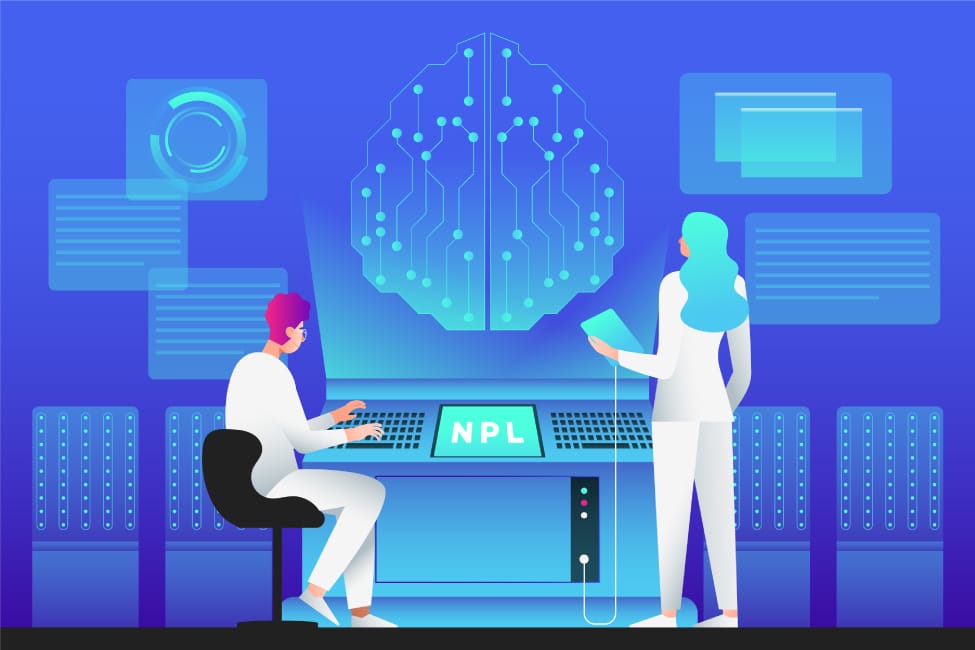How to Use Python for Deep Learning, Natural Language Processing, Computer Vision, and More
Python and Artificial intelligence, which has been last past years, has grown significantly. You have come to the perfect site if you want to learn more about Python and Artificial Intelligence, which is more vital than ever. You can understand artificial intelligence concepts and actual Python implementations by reading this blog article on the subject.
What is Python?
Python is a high-level, all-purpose programming language that has a beautiful syntax that enables programmers to concentrate more on solving problems than on catching syntax mistakes. Maintaining the fun factor of Python is one of their main priorities. Modern software development, infrastructure management, and notably data science have all become booming industries for Python. Python most recently moved up to the top 3 languages on the TIOBE popularity ranking.
What is Artificial Intelligence?
In 1956, during the Dartmouth conference, John McCarthy first used the term artificial intelligence. He described AI in terms of science and engineering interest in creating intelligent devices. Artificial intelligence is the branch of study that focuses on teaching machines to think and act like humans. Recent advancements in AI keep these tools and robots on the verge of being employed in a wide range of industries, including healthcare, robotics, marketing, business analytics, and many more.

Why is Python the best?
Python is a general-purpose programming language with methods for a variety of advanced technologies such as Artificial Intelligence, Machine Learning, Deep Learning, and others. Developers with Python programming credentials have a competitive advantage over those without.
- Less Code
AI implementation requires a massive amount of algorithms. We don’t need to code algorithms because Python supports pre-defined packages. Python offers a “check as you code” style that lessens the load of testing the code to further simplify matters.
- Prebuilt Libraries
To implement various Machine Learning and Deep Learning algorithms, Python comes with around 100 pre-built libraries. All it takes to run an algorithm on a collection of data is to establish and load the needed packages using a single command. Pre-built libraries contain, for illustration, Pytorch, Keras, Tensorflow, and NumPy.
- Ease of learning
Python includes a fairly specific syntax that can be exploited to do everything from explicit functions like adding two strings to more complicated functions like building a machine learning prototype.
- Platform-Independent
Python is consistent with a combination of operating systems, including Windows, MacOS, Linux, Unix, and others. Operate programs like PyInstaller, which intentionally brings respect to any dependency concerns when repositioning code between platforms.
- Massive Community Support
When we get into coding issues, the large user base of Python is always beneficial. In addition to having a sizable fan base, Python offers numerous communities, groups, and forums where programmers may discuss their mistakes and assist one another.
Deep learning
Neural networks are utilized in the machine learning component of deep learning to learn from data. Engineers that specialize in deep learning normally perform projects like speech and image recognition, natural language processing, and predictive modeling. They might also work on projects like building and optimizing neural network designs and training and deploying deep learning models.
In the intriguing and quickly developing discipline of deep learning, artificial neural networks are used to simulate and solve challenging problems. Python’s extensive ecosystem of tools and frameworks created expressly for deep learning has made it the most popular programming language in this field. Keep in mind that deep learning is a broad area and that remaining current with the most recent developments and best practices requires continual learning and testing.
Artificial Neural Networks (ANNs)
The fundamental units of deep learning are ANNs. They are made up of linked layers of synthetic neurons and are modeled after the composition and operation of the human brain. Each neuron applies a mathematical operation to its inputs before transmitting the outcome to the following layer. Artificial neural networks are a fundamental concept in machine learning and artificial intelligence. ANNs are comprised of connected nodes organized in layers and are computer models motivated by the arrangement and function of the human brain. A combination of tasks, such as classification, deterioration, image recognition, and natural language processing, can be conducted with ANNs.
Data Preparation
Python programming and artificial intelligence (AI) methods are used to clean, preprocess, and transform raw data into a format that is appropriate for analysis, machine learning, or other AI-related tasks. Data preparation is quick and easy using Python’s vast selection of packages and tools. Keep in mind that the quality of your results is greatly influenced by the quality of the prepared data. Data preparation is an essential phase in the data science workflow. AI models and analyses will be more accurate and dependable if data cleaning, transformation, and documentation are given careful consideration.
Model Architecture
Model architecture describes the layout and organization of a deep learning or machine learning model. It outlines the configuration of the model’s layers, neurons, and connections to process input data and generate predictions as output. A suitable model architecture must be developed if you want to complete your assignment successfully. The elaborateness of your model architecture should be compared to the problem of your work and the importance of the data you maintain at your disposal. Extremely complex models run the risk of overfitting, while overly specific standards run the risk of underfitting.
Natural language processing
A component of artificial intelligence called natural language processing concentrates on developing algorithms and techniques that can understand and build human language. Engineers that specialize in natural language processing commonly operate on tasks like text classification, language translation, and speech recognition. Also, they could be charged with exercises like building and handling natural language processing systems as well as developing and using natural language processing algorithms.
Artificial intelligence and machine learning methods are used in natural language processing with Python to understand, estimate, and build human language. Python is a well-liked alternative for NLP workloads because of its comprehensive ecosystem of devices and frameworks. Python-based natural language processing (NLP) with AI is a fast-developing topic with continuing research. Working on NLP projects successfully requires being current on the newest developments and best practices.
Text Preprocessing
Preparing raw text data for analysis, machine learning, or other natural language processing (NLP) activities entails cleaning, converting, and prepping it. The performance of subsequent NLP models is improved by effective text preparation, which also serves to improve the quality of the data. You can move on to more complex NLP tasks like sentiment analysis, topic modeling, text classification, or machine translation after text preprocessing. Keep in mind that the details of your NLP task and the features of your dataset should dictate your text preparation decisions.
Text Representation
Natural language processing requires the modification of unprocessed text data into numerical vectors that can be processed and studied by machine learning algorithms. This method is known as text representation, frequently referred to as text encoding or feature extraction. Text representation makes it possible to convert textual data into a format that models for operations like sentiment analysis, text categorization, topic modeling, and more may use. There are numerous ways to represent text data, and each one has advantages and use cases of its own. Numerous Python packages, like scikit-learn, Gensim, spaCy, and TensorFlow, offer tools for creating and interacting with different text representations.
Text Classification
Text classification is a key task in natural language processing (NLP), which entails categorizing or labeling texts according to predetermined categories. Numerous applications, including sentiment analysis, spam detection, subject categorization, and others, utilize it. Machine learning algorithms are used in text classification to determine patterns in marked text data and indicate the content of novel readers. Text categories can also create the benefit of more refined techniques and deep learning architectures, such as convolutional neural networks (CNNs) or recurrent neural networks (RNNs), especially when dealing with difficult issues or massive datasets.
Computer vision
A branch of artificial intelligence called computer vision focuses on creating algorithms and systems that can process and comprehend visual data. Typical duties for computer vision engineers include picture and video analysis, object detection, and facial recognition. They might even be interested in actions like building and handling computer vision systems and designing and setting computer vision algorithms into service.
Artificial intelligence and machine learning technologies are used in computer vision to analyze and interpret visual input from the outside world, such as photos and movies. Python is an excellent choice for computer vision projects because of its extensive ecosystem of devices and frameworks. A dynamic field with ongoing improvements in computer vision with Python and AI For computer vision projects to be completed successfully, it’s critical to keep up with the most recent theoretical developments and useful methodologies.
Image Processing
A fundamental idea in computer vision is called image processing, which entails adjusting and interpreting images to pull out data and improve their quality. Image processing is important for computer vision, which desires to create the potential for machines to interpret and comprehend visual data from all over the world. Scikit-image, a component of the Scikit-Learn ecosystem, and OpenCV are two well-known libraries for image processing and computer vision. These libraries are required for computer vision applications because they suggest a large capacity of components and techniques for image research, feature extraction, and manipulation.
Image Classification
Assigning a name or category to an input image based on its visual content is a fundamental computer vision problem known as image classification. It is one of the most prevalent and investigated issues in the area, with applications in anything from autonomous vehicles to medical diagnosis to object recognition in images. To perform better on difficult image classification tasks, more complicated CNN structures and algorithms might be applied.
Semantic Segmentation
The goal of the computer vision task known as semantic segmentation is to create a dense pixel-wise categorization by assigning a specific class label to each pixel in an image. Semantic segmentation adds a label to every pixel, thereby separating the image into regions with various semantic meanings, in contrast to object detection or instance segmentation, which concentrates on locating and recognizing specific objects. Advanced methods can boost segmentation accuracy and robustness even more. These methods include leveraging pre-trained backbones (like VGG or ResNet), using data augmentation, and using ensembles.
Conclusion
In conclusion, Python and AI provide a flexible and approachable framework for developing cutting-edge solutions for Deep Learning, Natural Language Processing, Computer Vision, and other applications. This article examines the various uses of AI, demonstrating how Python may be used for deep learning, natural language processing (NLP), computer vision, and more.







